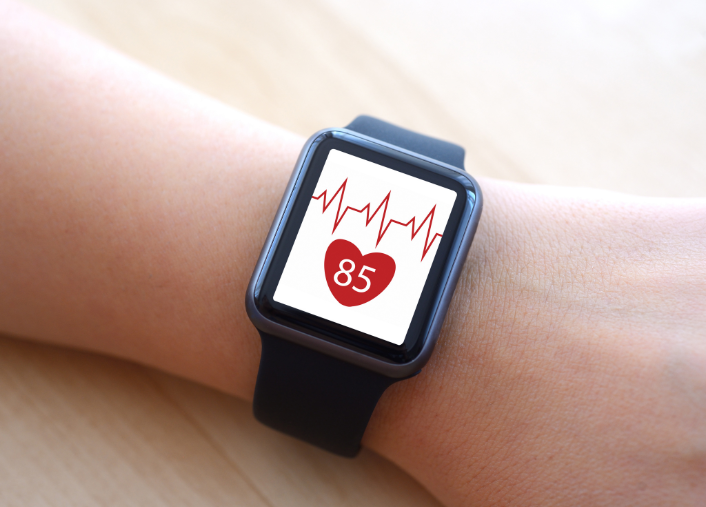
Resting heart rate is the number of times your heart beats per minute when you are resting. It measures cardiac activity when not influenced by physical activity, stress, or other external factors. Typically, we take this measurement in a calm, relaxed state, often in the morning, immediately after waking up.

Resting heart rate is a critical health indicator, as it reflects the efficiency and health of the heart. A lower resting heart rate indicates more efficient heart function and better cardiovascular fitness. It is also associated with reduced risks of cardiac events and longevity. Conversely, a high resting heart rate can be a risk factor for heart disease, hypertension, and other health issues.
Resting heart rates typically range between 60 to 100 beats per minute for adults. Athletes or highly active individuals often have a lower resting heart rate, sometimes as low as 40 beats per minute, due to more efficient heart function. The “ideal” heart rate can vary based on age, fitness level, and individual health conditions.
Regular cardiovascular exercise is the key to lowering your resting heart rate. Activities like walking, running, swimming, or cycling improve heart efficiency.
You can also try to maintain a healthy weight, manage stress, avoid tobacco use, limit caffeine and alcohol intake, and ensure adequate sleep. Consistency in these lifestyle choices leads to gradual improvements in heart rate over time.
Heart rate has a significant genetic component, with heredity accounting for 26–32% of its variation and even higher heritability (55–63%) reported in twin studies. Recent genome-wide association studies (GWAS) using genotyping arrays for single-nucleotide polymorphisms (SNPs) have successfully identified genetic variants near MYH6, GJA1, and CD34 that modestly influence heart rate.
The GJA1 gene in humans encodes for connexin 43 (Cx43). This protein is a type of gap junction protein found in the heart and other tissues. Gap junctions are specialized structures that allow direct communication between cells.
Connexin 43 plays a crucial role in maintaining normal rhythm and efficient functioning of our hearts. It enables the rapid and coordinated spread of electrical impulses across heart cells. These impulses are essential for synchronized heart muscle contractions, which pump blood throughout the body.
In a 2010 GWAS, researchers found a significant association with the SNP rs9398652 of the GJA1 gene. This variant is linked to a 12.6 ms shorter RR interval per the minor A allele, equating to a heart rate increase of 0.95 beats per minute. Another SNP, rs11154022, located just 8 kb from GJA1, also showed a significant genome-wide association but in the opposite direction, extending the RR interval and lowering heart rate. These SNPs have a low correlation with each other, suggesting independent genetic influences on heart rate.
The MYH6 gene encodes the alpha-heavy chain subunit of cardiac myosin. This protein is vital for the mechanism that helps your heart muscles contract and is found in the heart’s muscle cells, specifically the atria (the heart’s upper chambers). The alpha-heavy chain subunit plays a significant role in the heart’s mechanical function. It helps convert chemical energy into mechanical force, enabling the heart to pump blood effectively.
Genetic variations in the MYH6 gene can lead to various cardiac conditions, including cardiomyopathies, heart muscle disorders, and rhythm abnormalities, reflecting the gene’s essential role in maintaining normal heart function and rhythm.
The rs452036, located in MYH6’s intron 19, leads to a shorter RR interval (a key indicator of heart rate and heart rhythm) and higher heart rate per each C allele. This finding corroborates earlier research linking rs452036 to heart rate. The rs365990 variant in MYH6, causing an amino acid shift at position 1101, is closely related to rs452036 and may also be functionally significant.
Several non-genetic factors can influence an individual’s resting heart rate(the number of heartbeats per minute when the body is at rest). These factors include:
Regular exercise, especially cardiovascular activities, can lower resting heart rate by improving heart efficiency and health.
Resting heart rate typically increases slightly with age.
Stress, anxiety, and emotional distress can temporarily raise resting heart rate due to increased production of stress hormones like adrenaline.
Certain medications, such as beta-blockers, can lower resting heart rate, while decongestants or some antidepressants may increase it.
Both environmental temperature and body temperature can affect heart rate. Typically, heart rate increases in hot conditions to help cool the body.
Resting heart rate can be slightly higher when standing, compared to lying down, due to the heart working against gravity.
The use of nicotine and alcohol can increase resting heart rate. Chronic use can lead to long-term heart rate elevations.
Consuming caffeine can temporarily increase resting heart rate.
Poor sleep quality or inadequate rest can lead to a higher resting heart rate.
Various health issues, like thyroid diseases, anemia, or cardiovascular diseases, can influence resting heart rate.
Dehydration can elevate heart rate. Certain nutritional deficiencies or diet choices can also have an impact.
These non-genetic factors highlight the importance of a holistic approach to health, encompassing lifestyle, diet, emotional well-being, and medical care, in managing and understanding one’s resting heart rate.
To optimize your resting heart rate, which is an essential indicator of heart health and overall fitness, consider the following recommendations:
Making even small but consistent changes in your lifestyle can improve your resting heart rate and overall cardiovascular health.
*Understanding your genetics can offer valuable insights into your well-being, but it is not deterministic. Your traits can be influenced by the complex interplay involving nature, lifestyle, family history, and others.
Our reports have not been evaluated by the Food and Drug Administration. The contents on our website and our reports are for informational purposes only, and are not intended to diagnose any medical condition, replace the advice of a healthcare professional, or provide any medical advice, diagnosis, or treatment. Consult with a healthcare professional before making any major lifestyle changes or if you have any other concerns about your results. The testimonials featured may have used more than one LifeDNA or LifeDNA vendors’ product or reports.


